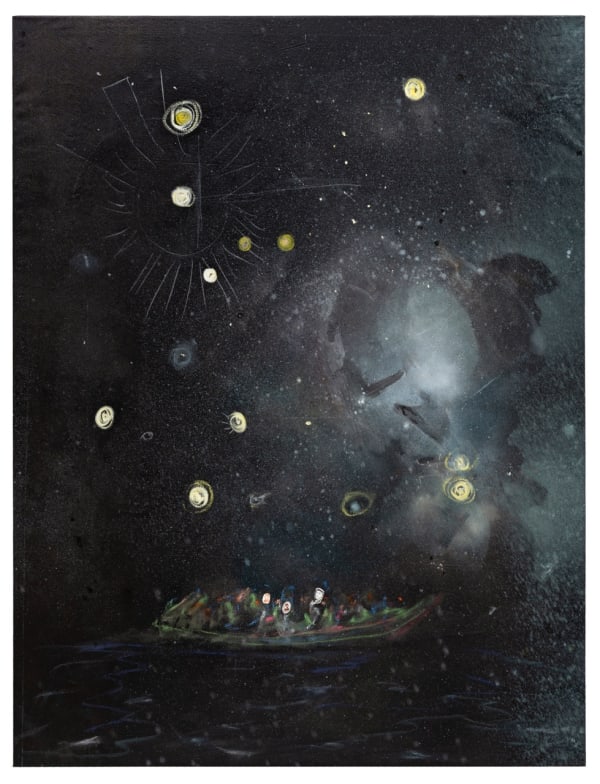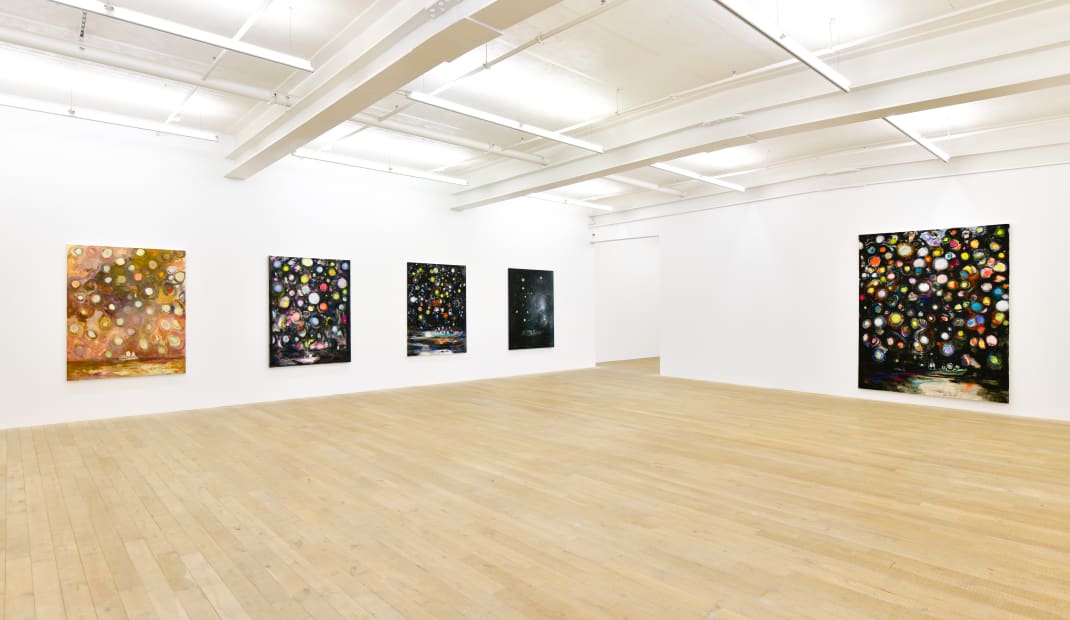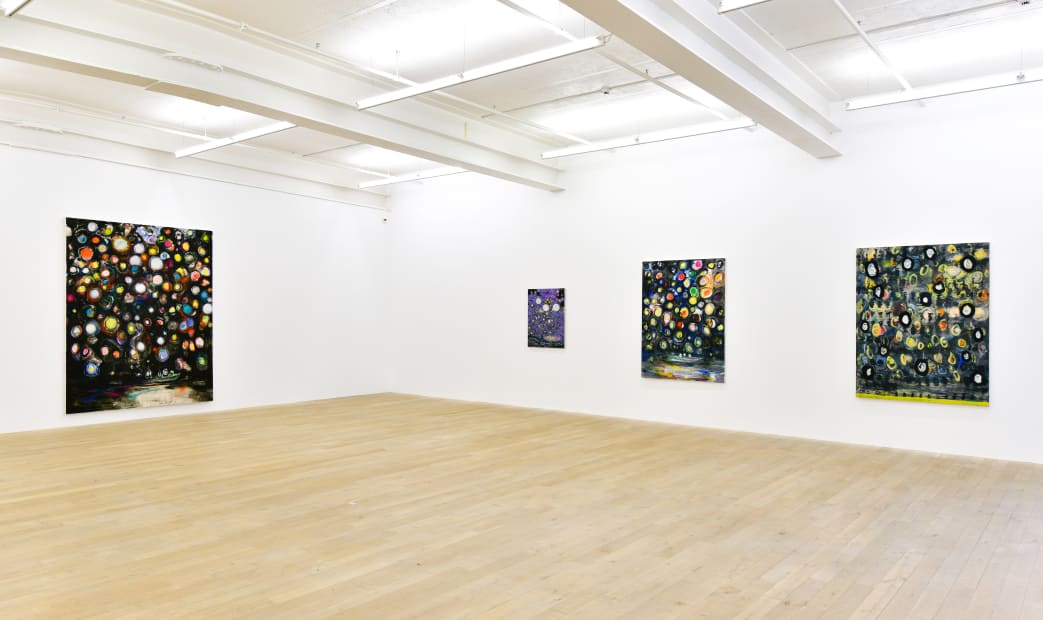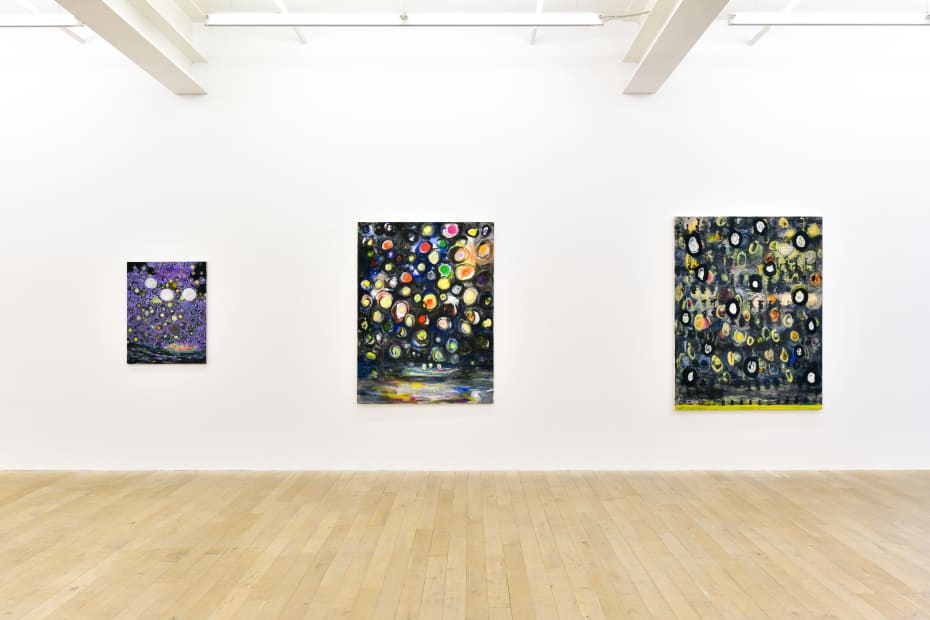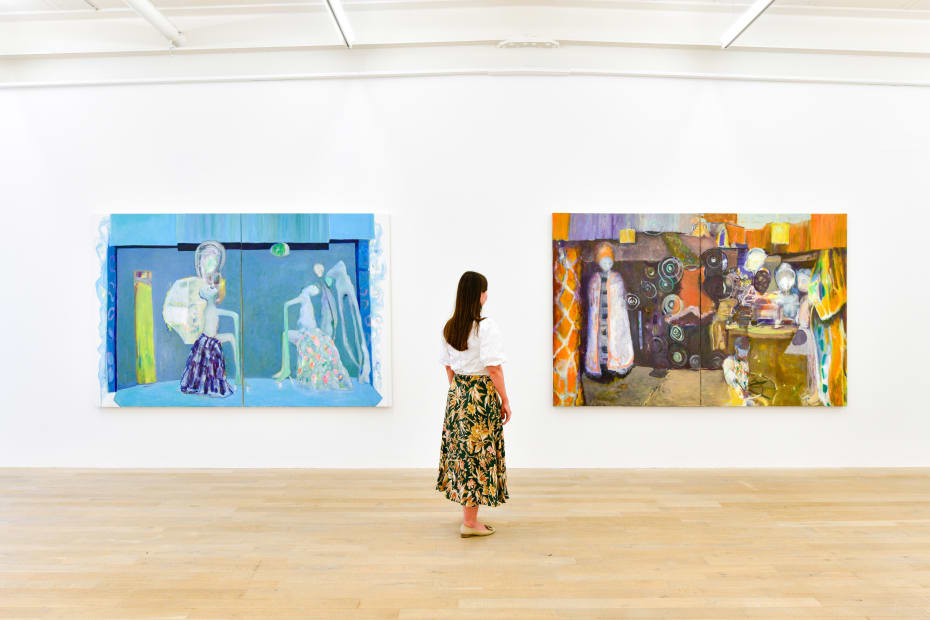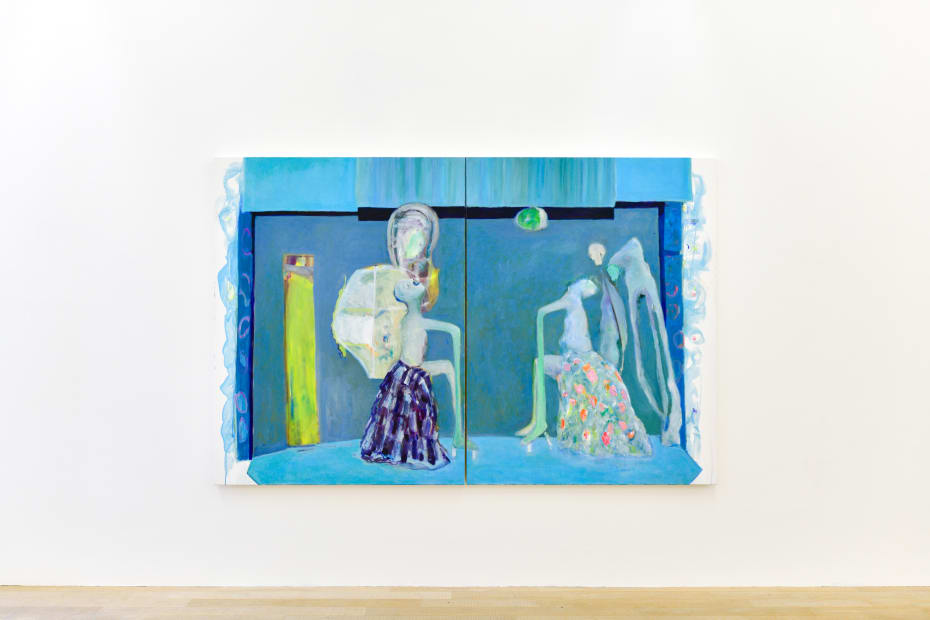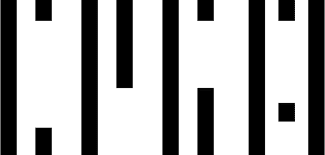For Favre, painting is a language of its own that initiates a dialogue of imagination and visual sensations with the viewer. Like a poet or thinker, she inserts her "words" into a fine fabric of multi-layered meanings, hinting at narratives that allow the viewer to reflect further. However, Favre's enthusiasm for the relationships between literature, art and philosophy is evident not only in her creative process. The originators of her sources of inspiration are also often visually cited in her compositions or become subject of her paintings by means of staging, as for example, in Favre's earlier groups of works on Hugo Ball and De Chirico.
The new series Bateau des poètes, from which the exhibition takes its name, is dedicated to a series of personalities who have influenced Favre's artistic work in different phases of her life. Each of the works depicts a nocturnal scene in a surreal universe: a firmament of countless moons and stars accompanies the voyage of a small barge gliding on the surface of a calm sea. While the night sky is rendered in a monochrome palette of sepia, midnight black or turquoise blue, the paste-like of round colour reflections on the celestial bodies are reminiscent of fireworks that make the smooth surface of the water shimmer. The image of the circle, as a graphic element, or as an allegory for the cycle of life, is a recurring motive in further works of the exhibition.
In each barque, the viewer recognises the faces - partly strikingly painted, partly printed by linocut - of well-known poets, thinkers or artists, most of whom committed suicide, such as Boris Ryzhy, Unica Zürn, Elsa Morandes, Inge Müller, Cesare Pavese and Mark Rothko; or were murdered, such as Rosa Luxemburg and Pier Paolo Pasolini (150 x 110 cm, see invitation card). But Dante Alighieri and Albert Einstein are also among the travellers. All of them are characters who reflected in a poetic, anarchic or absurd way on the meaning of life in art and science. Gliding in the barque as a group or alone, it remains unclear whether they are fleeing from something, undertaking an intellectual journey or passing into an uncertain beyond. The starting point for this series was the concept behind two earlier group of works entitled Selbstmord (Suicide, 2003 - 2013) and Fragment (ongoing since 2012) that Favre conflated into a new, contemplative cosmos. As a kind of in-between space, this cosmos reflects the uncertainty of our current zeitgeist in relation to themes such as immigration, the environment and sustainable perspectives.
In her group of works Le cabinet chinois (Nach James Ensor) (The Chinese Chamber (After James Ensor)), the artist captures an ephemeral state of transition. Inspired by the work Skeleton Looking at Chinoiseries by James Ensor (1860-1949), Favre creates an intimate interior, a kind of library or living room, in the centre of which, however, is not a skeleton but the seemingly surreal figure of a harlequin. Like Ensor, Favre made several versions of the scene so as not to limit herself to one point of view. Details of the furniture or the harlequin's facial features are only fleetingly hinted at. The flowing application of paint and the intense colour reflexes of yellow-gold, blue, green and purple tones are reminiscent of Pierre Bonnard's compositions. A heavy luminosity mixed with contour-less elements seems to veil another shadowy figure in the room. It is as if an afterlife would be present in the room through a metaphysical phenomenon. Through the transformation of the skeleton into a clown, however, death seems to have been defeated.
Transcendence as a philosophical-painterly moment is further explored in the work Genesis (130 x 250 cm). The scene reveals a view of a lush green pastoral landscape that runs into a distant horizon at the upper edge of the picture. Like an allegory of the dance of death, a female figure and a skeleton face each other in the front part of the painting. They are separated from each other by a kind of colourful fence. The figure in front turns her back to the viewer and seems to be interacting with the skeleton by gesticulating vehemently as if she were negotiating a crossing of the marked boundary. While the surroundings are reminiscent of Ferdinand Hodler's symbolically charged landscapes, the dreamlike, macabre aesthetic refers anew to James Ensor and other symbolists such as Odilon Redon.
The work occupies a certain individual position within the exhibition and, at the same time, forms a link to the monumental paintings Schimären-Chimères/ Bleibox (Chimera/Lead Box, 170 x 260 cm), Werkstatt (Workshop, 130 x 270 cm), and La Répétition (The Repetition, 170 x 260 cm), which tie in with Favre's pictorial narratives around the "theatre" as a parody of the world. Actors and props are assembled in a colourful staging, combining symbols around philosophical questions of life with literary references. The viewer abandons the position of spectator and becomes an actor himself.
Schimären-Chimères/ Bleibox is a direct continuation of Favre's theatrical stages in works such as Die Hellseherin (The Clairvoyant, 2014-2015) or Crystal Palace, 2015. In the right part of the painting, several characters have grouped around a table on which a casket is placed, alluding to the moral motif of choosing boxes from Shakespeare's play The Merchant of Venice. Its shimmering contents make the faces glow enigmatically. A person kneeling on the floor is dressed in an Elizabethan doublet. A red skirt without legs refers to the subject of the Robe Rouge (Red Robe), which has been a recurring motif in Favre's works since 1995. Further symbolic elements such as a bouquet of flowers and a stuffed crocodile stand as metaphors for nature packaged by humankind. On the left side of the picture, a statuesque figure is wrapped in a bodiless kimono, while the silhouettes of human shadows emerge in the dark background of the stage. A curved curtain at the right edge of the stage indicates the dynamics of a movement and its willingness to end the act soon.
The diptych La Répétition (The Repetition) shows the backstage of the scene described above. As in Favre's group of works Am Tisch (At the Table), the viewer becomes the secret observer of a theatre rehearsal. Two actors seem to be rehearsing, while a few brushstrokes behind a small passageway suggest the stage. The poses of the seated figures refer to Caravaggio's repentant Magdalena - a recurring motive in Favre's work.
In Werkstatt (Workshop), a multi-layered arrangement of props, such as a sewing machine and a small table with a kind of potter's wheel, refers to the location of the studio. It is a fictitious studio, as if set for the stage. Warm golden-brown tones and an unhinged shutter evoke the scent of wood and dust as one finds in old attics. Next to the small open window, a chicken flies in the soft sunlight. A female figure devotes herself to her handicraft, while to her right, a delicate silhouette observes the scene. As in Favre's Lapin Univers (Rabbit Universe) series, the artisan is an alter ego of herself. In the seclusion of the creative process, she finds a contemplative space of calm and fiction.
 Valérie FavreBateau des poètes (Diane Arbus, Boris Ryzhy, Unica Zürn, Mark Rothko), 2020Tempera, pastel and collage (linocut) on canvas250 x 195 cm (98.4 x 76.8 in.)
Valérie FavreBateau des poètes (Diane Arbus, Boris Ryzhy, Unica Zürn, Mark Rothko), 2020Tempera, pastel and collage (linocut) on canvas250 x 195 cm (98.4 x 76.8 in.) Valérie FavreBateau des poètes (Albert Einstein), 2021Oil and pastel on canvas150 x 110 cm (59.1 x 43.3 in.)
Valérie FavreBateau des poètes (Albert Einstein), 2021Oil and pastel on canvas150 x 110 cm (59.1 x 43.3 in.) Valérie FavreBateau des poètes (Dante Alighieri), 2020Oil on canvas170 x 130 cm (66.9 x 51.2 in.)
Valérie FavreBateau des poètes (Dante Alighieri), 2020Oil on canvas170 x 130 cm (66.9 x 51.2 in.) Valérie FavreBateau des poètes (Unica Zürn, Diane Arbus, Wladimir Majakowski), 2020Ink, pastel and collage (watercolor, pencil) on canvas170 x 130 cm (66.9 x 51.2 in.)
Valérie FavreBateau des poètes (Unica Zürn, Diane Arbus, Wladimir Majakowski), 2020Ink, pastel and collage (watercolor, pencil) on canvas170 x 130 cm (66.9 x 51.2 in.) Valérie FavreBateau des poètes, 2020Pigment, acrylic, pastel and collage (watercolor) on canvas170 x 130 cm (66.9 x 51.2 in.)
Valérie FavreBateau des poètes, 2020Pigment, acrylic, pastel and collage (watercolor) on canvas170 x 130 cm (66.9 x 51.2 in.) Valérie FavreBateau des poètes (Georg Trakl, Cesare Pavese, Ana Mendieta, Stig Dagerman, Virginia Woolf, Beatrice Hastings), 2020Tempera, pastel and collage (watercolor, pencil) on canvas170 x 130 cm (66.9 x 51.2 in.)
Valérie FavreBateau des poètes (Georg Trakl, Cesare Pavese, Ana Mendieta, Stig Dagerman, Virginia Woolf, Beatrice Hastings), 2020Tempera, pastel and collage (watercolor, pencil) on canvas170 x 130 cm (66.9 x 51.2 in.) Valérie FavreBateau des poètes (Rosa Luxemburg, Pier Paolo Pasolini), 2020/ 2021Oil on cotton150 x 110 cm (59.1 x 43.3 in.)
Valérie FavreBateau des poètes (Rosa Luxemburg, Pier Paolo Pasolini), 2020/ 2021Oil on cotton150 x 110 cm (59.1 x 43.3 in.) Valérie FavreLa Répétition, 2020/ 2021Diptych, oil on canvas170 x 260 cm (66.9 x 102.4 in.)
Valérie FavreLa Répétition, 2020/ 2021Diptych, oil on canvas170 x 260 cm (66.9 x 102.4 in.) Valérie FavreLe cabinet chinois (nach James Ensor), 2020/2021Oil on canvas85 x 65 cm (33.5 x 25.6 in.)
Valérie FavreLe cabinet chinois (nach James Ensor), 2020/2021Oil on canvas85 x 65 cm (33.5 x 25.6 in.)



